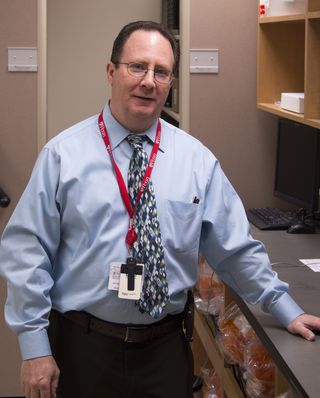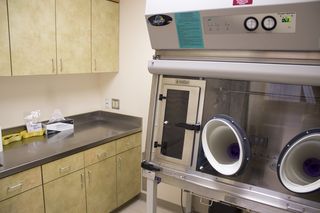 When Kenneth Rockwell Jr, PharmD, MS, director of the Investigational Drug Service (IDS) at Penn Medicine, started 21 years ago, the research pharmacy was a one-man operation.
When Kenneth Rockwell Jr, PharmD, MS, director of the Investigational Drug Service (IDS) at Penn Medicine, started 21 years ago, the research pharmacy was a one-man operation.
Since then, IDS – tasked with managing research medications used in clinical drug trials throughout Penn and many of its affiliates – has grown considerably. The latest step in that growth is marked by a new research pharmacy satellite site at Penn Presbyterian Medical Center (PPMC) that opened earlier this month. The unassuming two-room space is still eclipsed by the main 2,000 sq. ft. outpost where research drug manufacturing takes place at the Hospital of the University of Pennsylvania (HUP) — but the new site is a critical component of keeping the pharmaceutical aspects of nearly the entire Penn research engine moving.
Amassing four pharmacists, five research technicians, and six support staff, the team serves approximately 400 ongoing studies at any one time, spanning overnight inpatient trials at HUP and PPMC, as well as outpatient trials across the Penn campus, including Penn’s Vet, Dental and Nursing schools, as well as the Perelman School of Medicine and all UPHS-affiliated clinics.
“We are here just to handle research,” Rockwell Jr. explains – a statement that humbly minimizes the heavy involvement the team can play in hundreds of ongoing studies.
Research pharmacy staff review study protocols through regulatory steps and then collaborate with investigators and study sponsors to develop the medication portion of the research for investigator-initiated and industry studies. Maintaining accurate and efficient storage, inventory control, and security are critically important in their mission to dispense the correct medications in a timely manner to individual study participants around the clock.
In an industry study, in which Penn may be one of multiple participating sites, the study protocol is clearer cut than it typically is in the early stages of an investigator-initiated study. At the same time, many industry studies are not written by pharmacists, so logistically laying out how to ensure medication goes smoothly can be challenging.
“We have to figure out if a patient comes in after hours, how to get them a refill, a dose behind the scenes, and meet the sponsor’s requirements built into the research protocol,” Rockwell Jr. said. “The team plans this all out before a launch meeting in which they meet with the investigator, sponsor, and the study team and go over how everything will work.”
For an investigator-initiated study, pharmacy staff work with study authors on the medicine part of the study protocol from the ground up. Sometimes pharmacy residents or interns assist a researcher in finding a comparator drug, appropriate dosing, or drug information to submit to Penn’s institutional review board. The team formulates drugs, prepares randomization tables and prescriptions that physicians later complete, and records everything in electronic logs available for access from either location.
The IDS processes medications much like a traditional pharmacy, but only for study participants.
For example, if a researcher wants to compare drug A to drug B, the IDS will formulate a product for the study so that drug B looks, smells and tastes the same as drug A.
“We will assign subjects randomly to which treatment they will receive and keep everyone else masked so the investigator, the nurse, the patient, never know which drug the participant is taking,” said Rockwell Jr. “Behind the scenes, we’re making sure they’re consuming the right product and it’s all accounted for.”
Say in this scenario, drug A is given once daily and drug B is given three times a day. The IDS constantly adapts and adjusts if a patient needs a dosing change while keeping it masked, and monitors compliance and stores everything under lock and key. All documentation is continuously updated and readily available, especially for audits by the sponsor, U.S. Food and Drug Administration (FDA), or another group.
The team assists with submitting documents to the FDA for permission to use specific products – which can include natural products, drugs, vitamins, biologics and gene therapy agents – and performs testing needed to ensure those products are safe for human consumption.
One example of a current study the IDS team is working on involves a drug for which the study sponsors need thousands of pills to be precise down to one hundred microgram accuracy (a microgram is one millionth of a gram) using a machine that makes 30 capsules at a time followed by a weight check on every single capsule.
 The new pharmacy contains a negative pressure isolator that also allows staff to prepare chemotherapy, hazardous substances, stem cells, and other research tools for human use. A refrigerator, shelving space, hundreds of pill bottles lay the framework for the new research space.
The new pharmacy contains a negative pressure isolator that also allows staff to prepare chemotherapy, hazardous substances, stem cells, and other research tools for human use. A refrigerator, shelving space, hundreds of pill bottles lay the framework for the new research space.
The new opening answers a call for increasing support for research growth seen at PPMC and the north side of campus, partly resulting from the trauma center move. Having an outpost at PPMC is especially helpful when working around the clock to ensure processes proceed as intended.
Academically, the research pharmacy falls under the Institute for Translational Medicine and Therapeutics, so they are linked to the Clinical and Translational Research Center, Perelman Center for Advanced Medicine, and Children’s Hospital of Philadelphia.